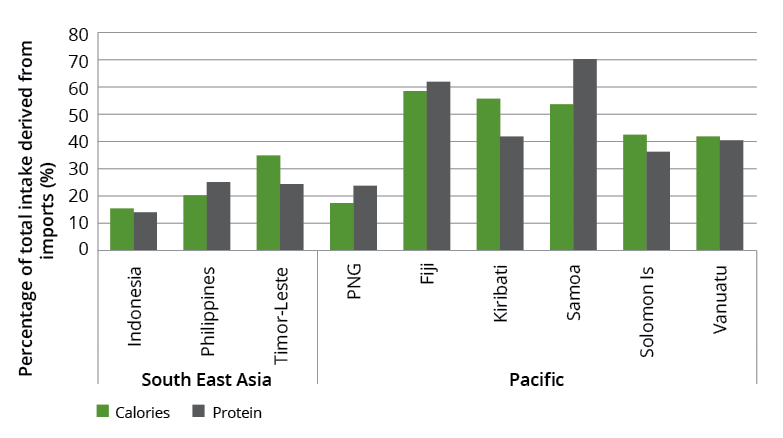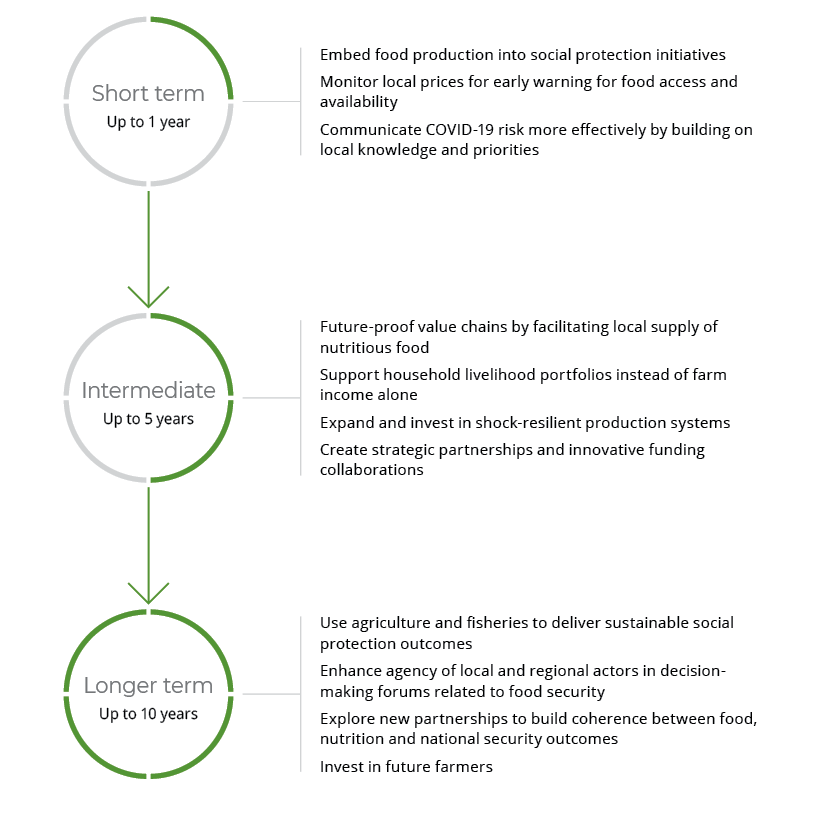ADB (Asian Development Bank) (2020). An updated assessment of the economic impact of COVID-19, ADB Briefs, No. 133, ADB, accessed 8 May 2020, www.adb.org/sites/default/files/publication/604206/adb-brief-133-updated-economic-impact-covid-19.pdf
ADB & UN Women (Asian Development Bank & United Nations Entity for Gender Equality and the Empowerment of Women) (2018). Gender equality and the Sustainable Development Goals in Asia and the Pacific: baseline and pathways for transformative change by 2030, ADB & UN Women, accessed 1 June 2020, www.adb.org/sites/default/files/publication/461211/gender-equality-sdgs-asia-pacific.pdf
Akter S, Rutsaert P, Luis J, Htwe NM, San SS, Raharjo B & Pustika A (2017). Women’s empowerment and gender equity in agriculture: A different perspective from Southeast Asia. Food Policy 69:270–9.
Alders R (2020). COVID-19: exposing shortfalls in support to human, animal and plant health in our region, devpolicy@ANU blog, 1 April 2020, http://devpolicy.org/covid-19-exposing-shortfalls-in-support-to-human-animal-and-plant-health-in-our-region-20200401/
Alders RG & Bagnol B (2007). Effective communication: the key to efficient HPAI prevention and control. World’s Poultry Science Journal 63:139–147.
Alders RG, Dar O, Kock R & Rampa F (in press, due to be launched 16 October 2020). One Health, Zero Hunger, Global Hunger Index Essay, www.globalhungerindex.org/about.html
Alders R, de Bruyn J, Wingett K & Wong J (2017). One Health, veterinarians and the nexus between disease and food security. Australian Veterinary Journal 95(12):45–453, doi:10.1111/avj.12645.
Alders RG, Ratanawongprasat N, Schönfeldt H & Stellmach D (2018). A planetary health approach to secure, safe, sustainable food systems: workshop report. Food Security 10(2):489–493, doi:10.1007/s12571-018-0780-9.
AMIS (Agricultural Market Information System) (2020). Market monitor No. 80, AMIS, accessed 10 July 2020, www.amis-outlook.org/fileadmin/user_upload/amis/docs/Market_monitor/AMIS_Market_Monitor_Issue_80.pdf
ASEAN (Association of Southeast Asian Nations) (2020). Declaration of the special ASEAN summit on coronavirus disease 2019 (COVID-19), ASEAN, Jakarta, accessed 1 June 2020
Barnes TS, Morais O, Cargill C, Parke CR & Urlings A (in press). First steps in managing the challenge of African swine fever in Timor-Leste. One Health 26 June 2020.
Barnes TS, Alvaran PJJ, Lantican TLDC, Lapuz EL, Ignacio C, Baluyut AS, Parke CR, Palaniappan G, Cameron D, Ancog RC, Mananggit MR, de Castro R, Meers J, Palmieri C, Turni C, Villar EC & Blackall PJ (2020). Combining conventional and participatory approaches to identify and prioritise management and health-related constraints to smallholder pig production in San Simon, Pampanga, Philippines. Preventive Veterinary Medicine 178, 104987, doi:10.1016/j.prevetmed.2020.104987.
Bourke RM, Gibson J, Quartermain A, Barclay K, Allen B & Kennedy J (2009). Part 2. Food production, consumption and imports. In: Bourke RM & Harwood T (eds) Food and agriculture in Papua New Guinea, ANU E Press, Canberra, 129-192, http://press-files.anu.edu.au/downloads/press/p53311/pdf/part21.pdf
Bushnell DM (2020). Financially advantageous approaches to sustain the ecosystem, AAI Foresight, accessed 5 June 2020, www.aaiforesight.com/sites/default/files/FR_Bushnell_WS2020_FinanciallyAdvantageousApproaches.pdf
Castriciones E & Vijayan V (2020). Biosecurity risk mapping and gap analysis in South East Asia. Journal of Biosafety and Biosecurity 2(1):36–43, doi:10.1016/j.jobb.2020.03.001.
Catley A, Alders RG, Woods J (2012). Participatory epidemiology: approaches, methods, experiences. Veterinary Journal 191(2):151–160, doi:10.1016/j.tvjl.2011.03.010.
Catley A, Burns J, Abebe D, Suji O (2013). Participatory impact assessment: A design guide, Feinstein International Center, Somerville, accessed 15 May 2020, http://fic.tufts.edu/assets/PIA-guide_revised-2014-3.pdf
Charlton KEJ, Russell E, Gorman Q, Hanich A, Delisle B, Campbell & Bell J (2016). Fish, food security and health in Pacific island countries and territories: a systematic literature review. BMC Public Health 16(1):285.
Chatterjee B & Khadka M (eds) (2011). Climate Change and Food Security in South Asia, CUTS International, Jaipur, India.
CHF (Commission for the Human Future) (2020). Roundtable on global food security: food is at the heart of our future, CHF, Canberra, accessed 30 June 2020, www.humanfuture.net/sites/default/files/Final%20Report%20on%20Food%20Security_0.pdf
CHS (Indo-Pacific Centre for Health Security) (2019). Health security in the Indo-Pacific: state of the region 2019, CHS, DFAT, Canberra, accessed 6 July 2020, https://indopacifichealthsecurity.dfat.gov.au/resources-hub#Policy,%20Strategy%20&%20Research
Cleaveland S, Sharp J, Abela-Ridder B, Allan KJ, Buza J, Crump JA, Davis A, Del Rio Vilas VJ, de Glanville WA, Kazwala RR, Kibona T, Lankester FJ, Lugelo A, Mmbaga BT, Rubach MP, Swai ES, Waldman L, Haydon DT, Hampson K & Halliday JEB (2017). One Health contributions towards more effective and equitable approaches to health in low- and middle-income countries. Philosophical Transactions of the Royal Society B, 372(1725), doi:10.1098/rstb.2016.0168.
Davila F (2019). Human ecology and food discourses in a smallholder agricultural system in Leyte, The Philippines. Agriculture and human values 37:719–741, doi:10.1007/s10460-019-10007-6
Dawe D (2020a). Impacts of coronavirus on food security and nutrition in Asia and the Pacific: building more resilient food systems, Policy Brief. Food and Agriculture Organization of the United Nations (FAO), Bangkok, accessed 20 June 2020, www.fao.org/documents/card/en/c/ca9473en
Dawe D (2020b). Why export restrictions should not be a response to COVID-19: Learning lessons from experience with rice in Asia and the Pacific, Food and Agriculture Organization of the United Nations (FAO), Bangkok, accessed 20 June 2020, www.fao.org/documents/card/en/c/ca9362en
de Bruyn J, Ferguson E, Allmann-Farinelli M, Darnton-Hill I, Maulaga W, Msuya J & Alders R (2016). Food composition tables in resource-poor settings: exploring current limitations and opportunities, with a focus on animal-source foods in sub-Saharan Africa. British Journal of Nutrition 116:1709–1719.
De Guzman R & Malik M (2020). Dual challenge of cancer and COVID-19: impact on health care and socioeconomic systems in Asia Pacific. JCO Global Oncology 6:906–912, doi:10.1200/GO.20.00227.
DFAT (Department of Foreign Affairs and Trade) (2017). Foreign policy white paper, accessed 9 August 2020, www.dfat.gov.au/sites/default/files/2017-foreign-policy-white-paper.pdf
DFAT (Department of Foreign Affairs and Trade) (2018). Pacific Health Security Scoping Mission: Papua New Guinea Country Report following consultations in Port Moresby and Goroka, 9–14 April 2018, accessed 15 September 2020. https://indopacifichealthsecurity.dfat.gov.au/Scoping%20Mission%20Report%20-%20Papua%20New%20Guinea
DFAT (Department of Foreign Affairs and Trade) (2020). Partnerships for recovery: Australia’s COVID-19 development response, Department of Foreign Affairs and Trade, Canberra, accessed 5 July 2020, www.dfat.gov.au/publications/aid/partnerships-recovery-australias-covid-19-development-response
Doss C, Meinzen-Dick R, Quisumbing A & Theis S (2017). Women in agriculture: four myths. Global Food Security 16:69–74, doi:10.1016/j.gfs.2017.10.001.
Dujardin S, Hermesse J & Dendoncker N (2018). Making space for experiential knowledge in climate change adaptation. Insights from municipal planning officers in Bohol, Philippines. Journal of Disaster Risk Studies 10(1):433, doi:10.4102/jamba.v10i1.433.
FAO (Food and Agriculture Organization of the United Nations) (2012). Decent rural employment for food security: a case for action, Gender, equity and rural employment division, economic and social development department, FAO, Rome, accessed 15 May 2020, www.fao.org/3/i2750e/i2750e00.pdf
FAO (Food and Agriculture Organization of the United Nations) (2018a). Asia and the Pacific regional overview of food security and nutrition 2018—accelerating progress towards the SDGs, FAO, Bangkok.
FAO (Food and Agriculture Organization of the United Nations) (2018b). Developing gender-sensitive value chains—guidelines for practitioners, FAO, Rome, accessed 15 May 2020, www.fao.org/3/i9212en/I9212EN.pdf
FAO (Food and Agriculture Organization of the United Nations) (2020a). Impacts of coronavirus on food security and nutrition in Asia and the Pacific: building more resilient food systems, 5 June 2020, FAO, accessed 30 June 2020, www.fao.org/3/ca9473en/CA9473EN.pdf
FAO (Food and Agriculture Organization of the United Nations) (2020b). Mitigating the impacts of COVID-19 on the livestock sector, 23 April 2020, FAO, accessed 15 May 2020, www.fao.org/3/ca8799en/CA8799EN.pdf
FAO (Food and Agriculture Organization of the United Nations) (2020c). One Health, accessed 23 July 2020, www.fao.org/asiapacific/perspectives/one-health/en/
FAO, IFAD, UNICEF, WFP& WHO (2020). The state of food security and nutrition in the world 2020: transforming food systems for affordable healthy diets, FAO, Rome, accessed 12 August 2020, doi:10.4060/ca9692en.
FAO-PG (Food and Agriculture Organization of the United Nation, Papua New Guinea Offices) (2020). Food security situation report No. 03-2020, FAO-PG, reporting period: 26 May – 30 June 2020.
FAO RAP (Food and Agriculture Organization of the United Nations Regional Office for Asia and the Pacific) (2020). Gender, FAO RAP, Bangkok, accessed 20 June 2020, www.fao.org/asiapacific/programmes-and-projects/gender/en/
Garcia SN, Osburn BI & Jay-Russell MT (2020). One Health for food safety, food security, and sustainable food production. Frontiers in Sustainable Food Systems 4(28 January 2020), doi:10.3389/fsufs.2020.00001.
GDS (General Directorate of Statistics) (2015). Timor-Leste demographic and health survey, National Directorate for Statistics, Ministry of Finance, Dili, accessed 15 June 2020, https://dhsprogram.com/pubs/pdf/FR329/FR329.pdf
Gopalakrishnan T, Hasan MK, Haque ATMS, Jayasinghe SL & Kumar L (2019). Sustainability of coastal agriculture under climate change. Sustainability 11:7200. doi:10.3390/su11247200.
Grundy J, Annear P, Chomat AM, Ahmed S & Biggs BA (2014). Improving average health and persisting health inequities—towards a justice and fairness platform for health policy making in Asia. Health Policy and Planning 29(7): 873–882, doi:10.1093/heapol/czt068.
Hassell JM, Begon M, Ward MJ & Fèvre EM (2017). Urbanization and disease emergence: dynamics at the wildlife-livestock-human interface. Trends in Ecology & Evolution 32(1):55–67, doi:10.1016/j.tree.2016.09.012.
Hidrobo M, Kumar N, Palmermo T, Peterman A & Roy S (28 April 2020). Why gender-sensitive social protection is critical to the COVID-19 response in low- and middle-income countries, International Food Policy Research Institute, accessed 15 June 2020, www.ifpri.org/blog/why-gender-sensitive-social-protection-critical-covid-19-response-low-and-middle-income
HLPE (High Level Panel of Experts on Food Security and Nutrition of the Committee on World Food Security) (2020). Food security and nutrition: building a global narrative towards 2030, A report by the High Level Panel of Experts on Food Security and Nutrition of the Committee on World Food Security, Rome.
Hodson R (2017). Food security. Nature 544(7651), S5, doi:10.1038/544S5a.
ILO (International Labour Organization) (2018). Employment in Asia-Pacific continues to grow but often remains of poor quality, International Labour Organization in Asia and the Pacific, 22 January 2018, accessed 15 May 2020, www.ilo.org/asia/media-centre/news/WCMS_615872/lang--en/index.htm
IPCC (Intergovernmental Panel on Climate Change) (2020). Climate change and land: special report on climate change, desertification, land degradation, sustainable land management, food security, and green house gas fluxes in terrestrial ecosystems: summary for policymakers, IPCC, accessed 25 May 2020, www.ipcc.ch/site/assets/uploads/sites/4/2020/02/SPM_Updated-Jan20.pdf
Janssens C, Havlik P, Krisztin T, Baker J, Frank S, Hasegawa T, Leclère D, Ohrel S, Ragnauth S, Schmid E, Valin H, Van Lipzig N & Maertens M (2020). Global hunger and climate change adaptation through international trade. Nature Climate Change 10:829–835, doi:10.1038/s41558-020-0847-4.
Kim, K, Kim S & Park C-Y (2020). Food security in Asia and the Pacific amid the COVID-19 pandemic, ADB Briefs, No 139, Asian Development Bank, accessed 24 June 2020, www.adb.org/publications/food-security-asia-pacific-covid-19
Kyeema (2020). Rapid pre-testing of African swine fever communication material in Morobe Province, PNG, Kyeema Foundation report to the Burnet Institute, 26 June 2020, Kyeema Foundation, Brisbane, Australia.
Lal A, Fearnley E & Wilford E (2019). Local weather, flooding history and childhood diarrhoea caused by the parasite Cryptosporidium spp.: a systematic review and meta-analysis. Science of the Total Environment 674:300–306.
Lipton M (1977). Why people stay poor: urban bias in world development, Temple Smith, New York.
Lysaght T, Capps B, Bailey M, Bickford D, Coker R, Lederman Z, Watson S & Tambyah PA (2017). Justice is the missing link in One Health: results of a mixed methods study in an urban city state. PLoS ONE 12(1):e0170967, doi:10.1371/journal.pone.0170967.
MacIntyre R (2019). The risk of selective investment in downstream pandemic planning. Global Biosecurity 1(2):85–90, doi:10.31646/gbio.36.
MacPherson G (2017). Regional security implications of climate change and natural disasters in the South Pacific. Indo-Pacific Strategic Digest 257–268, www.defence.gov.au/ADC/Publications/documents/digest/Spring_2017/IPSD_MacPherson_spring2017.pdf
Maggiore A, Afonso A, Barrucci F & de Sanctis G (2020). Climate change as a driver of emerging risks for food and feed safety, plant, animal health and nutritional quality. Climate change and food safety, European Food Safety Authority (EFSA), 146, doi:10.2903/sp.efsa.2020.EN-1881.
McFarlane RA, Sleigh AC & McMichael AJ (2013). Land-use change and emerging infectious disease on an island continent. International Journal of Environmental Research and Public Health 10(7):2699–2719, doi:10.3390/ijerph10072699.
Mola G (1 May 2020). Handling the corona virus epidemic in Papua New Guinea [Facebook], www.facebook.com/permalink.php?story_fbid=1481634785342506&id=100004879960218
Pangestu M (1 May 2020). Hunger amid plenty: How to reduce the impact of COVID-19 on the world’s most vulnerable people, accessed 28 June 2020, https://blogs.worldbank.org/voices/hunger-amid-plenty-how-reduce-impact-covid-19-worlds-most-vulnerable-people
Peiris M & Yen HL (2014). Animal and human influenzas. Revue scientifique et technique (International Office of Epizootics) 33(2):539–553.
Perkins D, Radalet S, Lindauer D & Block S (2012). Economics of development, 7th edn., W.W. Norton, New York.
PIFS (Pacific Islands Forum Secretariat) (2018). Boe declaration on regional security, PIFS, accessed 20 May 2020, www.forumsec.org/2018/09/05/boe-declaration-on-regional-security/
Plahe JK, Hawkes, S & Ponnamperuma S (2013). The corporate food regime and food sovereignty in the Pacific islands. The Contemporary Pacific 25(2):309–338.
PLAN International & Save the Children (2020). Because we matter: addressing COVID-19 and violence against girls in Asia-Pacific, PLAN International, accessed 16 July 2020, www.plan.org.au/-/media/plan/documents/learn/publications/becausewematter.pdf
Provo A, Atwood S, Sullivan EB & Mbuya N (2017). Malnutrition in Timor-Leste: A review of the burden, drivers, and potential response, DFAT, The World Bank and the European Commission.
Rampa F, Dekeyser K, Alders R & Dar O (2019). The global institutional landscape of food and agriculture: how to achieve SDG 2, Discussion paper No. 265, Maastricht, Netherlands, European Centre for Development Policy Management; London, accessed 12 June 2020, https://ecdpm.org/wp-content/uploads/Global-Institutional-Landscape-Food-Agriculture-How-To-Achieve-SDG2-ECDPM-Discussion-Paper-265-With-Chatham-House.pdf
Sanderson T, Chapman G, Walker D & Horne P (2020). Food systems security, resilience and emerging risks in the Indo-Pacific in the context of COVID-19: a rapid assessment, Technical Reports Series, No. 95, ACIAR, Canberra.
Schmidhuber J, Pound J & Qiao B (2020). COVID-19: Channels of transmission to food and agriculture, policy brief, Food and Agriculture Organization of the United Nations (FAO), Rome, accessed 28 June 2020, www.fao.org/documents/card/en/c/ca8430en/
Simpson A, Cummins P, Dhu T, Griffin J & Schneider J (2008). Assessing natural disaster risk in the Asia-Pacific Region. AusGeo News, Issue 90, June 2008, Geoscience Australia. www.ga.gov.au/webtemp/image_cache/GA11300.pdf
SPC, SPREP, PIFS, UNDP, UNISDR & USP (Pacific Community, Secretariat of the Pacific Regional Environment Programme, Pacific Islands Forum Secretariat, United Nations Development Programme, United Nations Office for Disaster Risk Reduction & University of the South Pacific) (2016). Framework for resilient development in the Pacific: an integrated approach to address climate change and disaster risk management (FRDP) 2017–2030, SPC, SPREP, PIFS, UNDP, UNISDR & USP, http://tep-a.org/wp-content/uploads/2017/05/FRDP_2016_finalResilient_Dev_pacific.pdf
Tatem AJ, Rogers DJ & Hay SI (2006). Global transport networks and infectious disease spread. Advances in Parasitology 62:293–343, doi:10.1016/S0065-308X(05)62009-X.
TNP2K (The National Team for The Acceleration of Poverty Reduction) (2018). Government pushes for stunting prevention in 100 regency and cities, TNP2K, 22 November 2018, accessed 9 June 2020, www.tnp2k.go.id/articles/government-pushes-for-stunting-prevention-in-100-regency-and-cities
UN (United Nations) (1992). Convention on biological diversity, UN, New York, accessed 17 June 2020, www.cbd.int/doc/legal/cbd-en.pdf
UN (United Nations) (2015). Transforming our world: the 2030 Agenda for Sustainable Development, UN, New York, accessed 17 June 2020, https://sdgs.un.org/2030agenda
UN (United Nations) (2019). Political declaration of the high-level meeting on universal health coverage, UN, New York, accessed 17 June 2020, www.un.org/pga/73/wp-content/uploads/sites/53/2019/07/FINAL-draft-UHC-Political-Declaration.pdf
UNDRR (United Nations Office for Disaster Risk Reduction) (2015). Sendai Framework for Disaster Risk Reduction 2015-2030, UNDRR, New York, accessed 17 June 2020, www.preventionweb.net/files/43291_sendaiframeworkfordrren.pdf
UNFPA (United Nations Fund for Population Activities) (2020). Gender equality, UNFPA Asia and the Pacific Office, accessed 15 July 2020, https://asiapacific.unfpa.org/en/node/15206
UN News (United Nations News) (2020). What does ‘build back better’ really mean? One of the world’s top CEOs give us his take, UN News, 11 June 2020, https://news.un.org/en/story/2020/06/1066152
Waage JK & Mumford JD (2008). Agricultural biosecurity. Philos. Trans. R. Soc. Lond B Biol Sci 363(1492):863–876.
Woodhill J, Hasnain S & Griffith A (2020). Farmers and food systems: what future for small-scale agriculture? Environmental Change Institute, University of Oxford, Oxford, accessed 18 July 2020, www.foresight4food.net/wp-content/uploads/2020/01/Farming-food-WEB.pdf
World Bank (2020). Food security and COVID-19, World Bank, accessed 28 June 2020, www.worldbank.org/en/topic/agriculture/brief/food-security-and-covid-19
World Vision Australia (2020). COVID-19 emergency response Asia Pacific regional situation, report No. 15, 2 July 2020.
World Vision International (2020). Out of time: COVID-19 aftershocks, World Vision International Publication, accessed 20 July 2020, www.wvi.org/sites/default/files/2020-07/Out%20of%20Time_Covid19%20Aftershocks%20-%20FINAL.pdf




